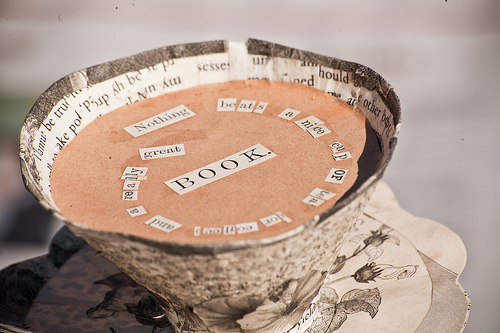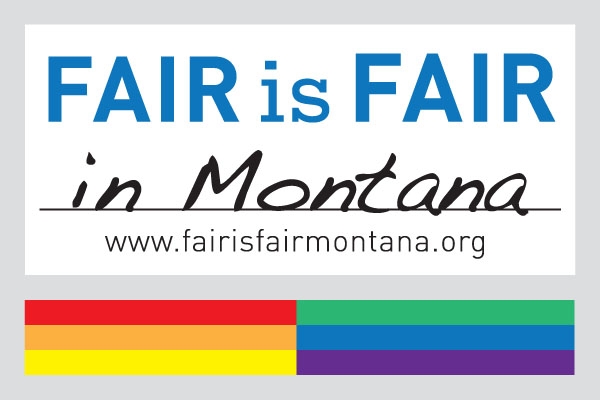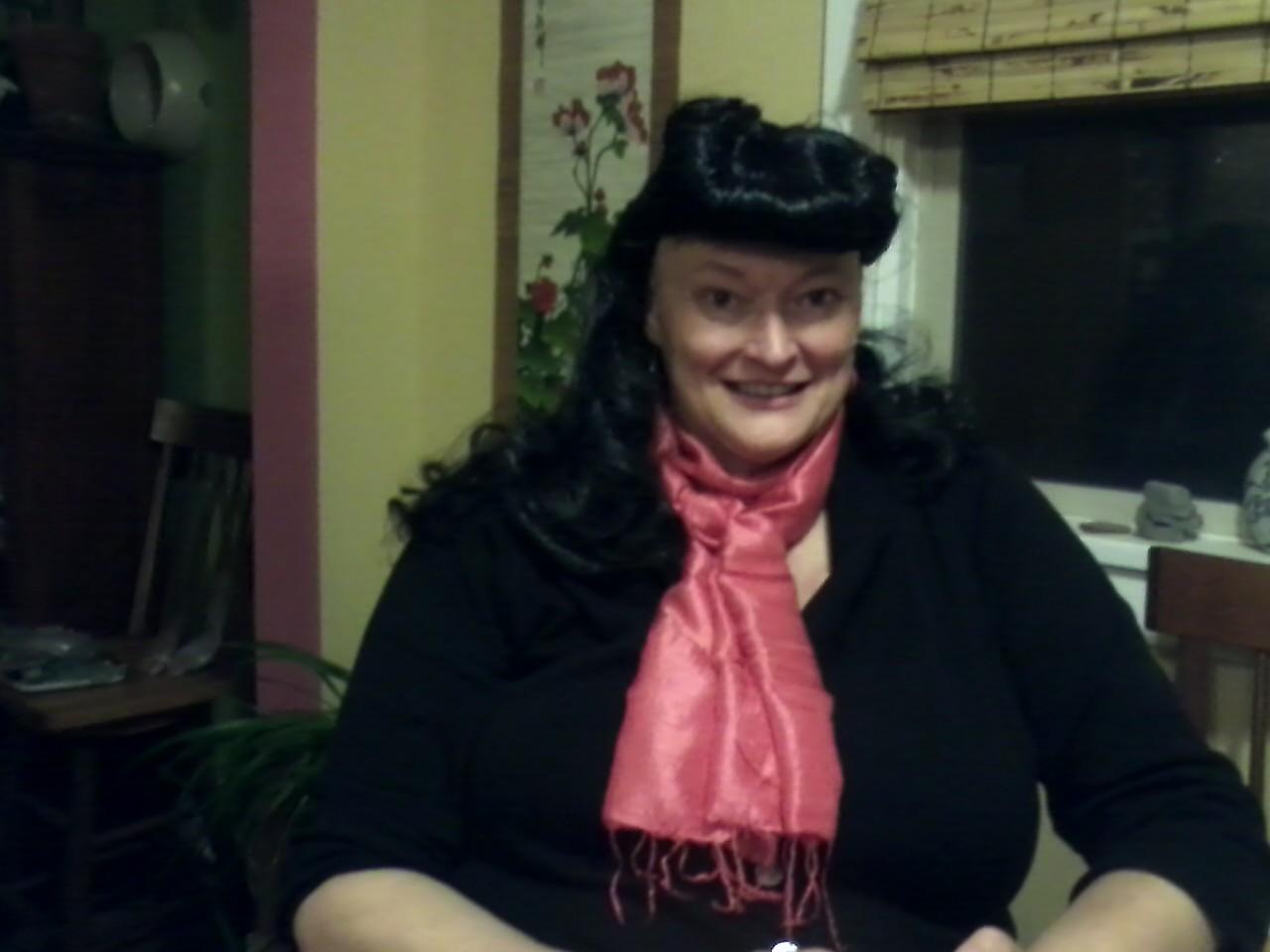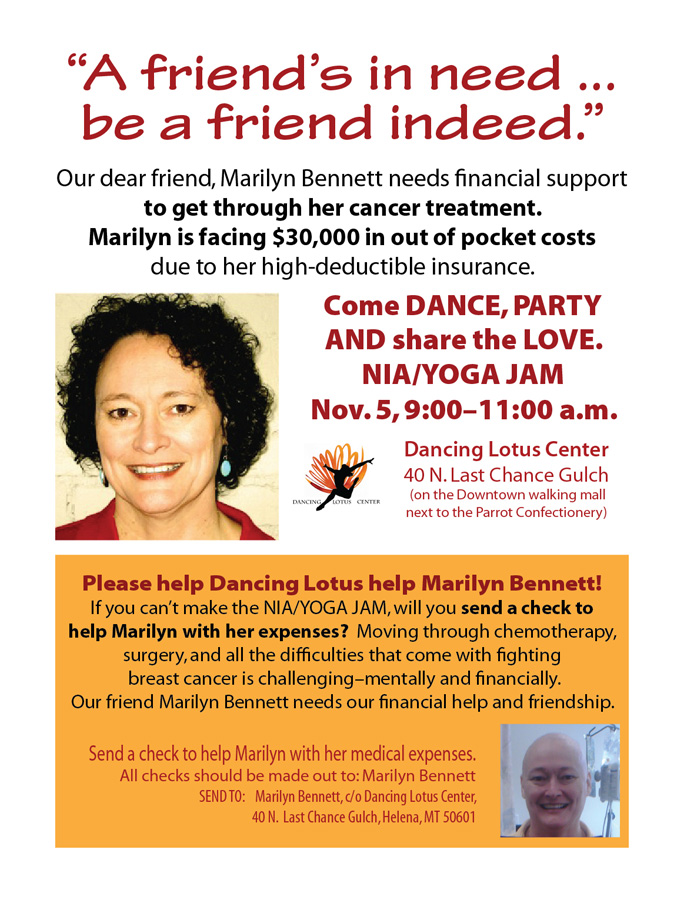Helping Hearts
What Inspires: Outreach I'm finally able to write what is on my mind. You know how it is: saying a thing (or writing it, in my case) makes it real. So often, when a thing is really sad, or bad, or scary--or all three and more--we hold off putting words to it in hopes that it won't be so. But it is so. My lovely, lively sister-in-law Marilyn is battling breast cancer. Marilyn just finished her fourth round of chemotherapy and is facing surgery, more chemo and maybe radiation treatment. If I were she, I'd be curled up in a ball in the corner somewhere. But Marilyn has laughter in her heart and so she is trying on Andrews Sisters-style wigs
(hopefully for Halloween and not every day wear hair), rejoicing because the side-effects of the 3rd chemo were less debilitating than those of the 2nd, and sending love notes such as this: "... So, all of you, know how fabulous you are and how much I appreciate your love, care, and humor. And even when I don't hear from you or see you, I don't doubt that you're rooting me on...and know, I'm in your corner too."
Because our health care system is what it is, even though Marilyn has insurance, she is still being slapped with massive medical expenses. In an effort to alleviate some of the worry of having to scratch up the money to pay for treatment so Marilyn can, instead, focus her energy where it should be focused--on beating the cancer and regaining vigor, friends organized a benefit for her. It was a grand and loving event but it didn't raise all the funds needed; please contribute if you're able. And join me in sending Marilyn light and healing energy.
Let's Make Like Bulbs!
What Inspires: Heirloom Bulbs Chris Weisinger, the Bulb Hunter, shares his boyhood memory of “one red tulip” which, like Jack’s bean, magically rose up from a shriveled brown “rock," in the forward to Heirloom Bulbs for Today.
That red tulip didn’t bloom another season, it didn’t need to; its work was done. In this gloriously illustrated, informative--and most importantly, fascinating--treasure, written with master gardener and author Cherie Foster Colburn, the Bulb Hunter writes of discovering daffodils, hyacinths, lilies, gladiolus and naked ladies marking the foundation of dilapidated shacks, ringing the base of ancient trees, marking all but invisible paths—“going through drought and flood, heat and cold.”
Like fine stories, these bulbs caught Chris's attention, lured him in, and sent him off searching for more.
Like fine stories, these bulbs survive, even thrive!
“Each bulb blooming today has a story to tell: it has traveled from somewhere, to someone. It was carried in the pocket of an immigrant coming to a New World, or symbolized the love of a child on a parent’s grave, or was divided from a clump in grandmother’s garden provide a “start” for a daughter’s new home. Each bulb comes with a full and seasoned past.”—The Bulb Hunter, Chris Weisinger.
Let’s make like heirloom bulbs: Thrive, prosper and create our stories!
Word Sculptors Inspire Paper Sculptures
What inspires: Paper Art created from and inspired by "libraries, books, words, ideas..." Somewhere out there a brilliant paper artist (artists?) has been using book pages and words to create adjective-defying sculptures and secretly depositing them in book places--libraries, shops, festivals--around Scotland. This paper sculpture mystery was brought to my attention in a blog posting by poet/writer/teacher/mentor, Julie Larios on the Vermont College of Fine Arts faculty site, Write at Your Own Risk.
Talk about mystical, magical, marvelous....creations "in support of libraries, words, books, ideas..." You have to see these Mysterious Paper Sculptures for yourself!.
The link above is to the Central Station site where the story, and photos of these amazing paper sculptures is posted. If you can't access it via my link, cut and paste it from here: http://community.thisiscentralstation.com/_Mysterious-paper-sculptures/blog/4991767/126249.html

- The cup is part of a scultpure found at the Edinburgh Internaitonal Festival Bookshop on Aug. 24, 2011. The swirling words read: "Nothing beats a nice cup of tea (or coffee) and a really good BOOK", and on the 'tray' next to the cupcake it says "except maybe a cake as well". There's also a teabag filled with cut out letters. The gift tags says: "by leaves we live".
May you be inspired to create a sculpture of your own...
Super Tomato Timer
What Inspires: 60-minute Kitchen Timers That tomato-shaped 60-minute kitchen timer perched on the spice shelf fills me with hope for the future…
Back when I was a teen, along with my mother, I was addicted to old movie—especially those all afternoon long Saturday and Sunday movie marathons. Weekend mornings we often went straight from our beds to the couch where we’d spend much of the day—sometimes late into the night—lounging in our comfy jammies watching movies—so many great movies; so many relaxing weekends.
Alas, relaxing weekend often found us scrambling Sunday night to finish chores, laundry, homework, housework… (Somehow, my brother, whose movie taste was different from ours, managed to skip out on our movie fests and the Sunday night hurry hurry scurry freak outs…go figure?) Then one weekend my mother had a brilliant idea: Let’s set the KITCHEN TIMER! At commercial breaks, news intervals, movie bits we’d seen and didn’t care if we saw again, we’d set the timer for a set number of minutes-depending. Then we’d jump up and race around doing chores until DING!
Mom’s Kitchen Timer Method (KTM) worked. We both, separately, still use it when we have chores we’re not crazy about doing. Yuck, tedious jobs like closet culling, file sorting, and spring cleaning, are so much easier to start when you know you can walk away after, say, 5 minutes… (okay, maybe not 5 but 20 works.) And it’s amazing what you can accomplish when you’re racing the timer.
As brilliant as KTM was, I thought it was worth trying with my kids since cajoling, begging, bribing, and misleading didn't. “Time to clean your rooms,” I’d say. “We’re going to play a game of pick up toys,” I’d say. “I have a fun idea, let’s dust!” Feeling quite clever, I pulled out the happy red tomato timer. “10 minutes,” I told Max and Lexi as I set the tomato ticking. “Let’s see how many socks we can sort in 10 minutes.”
“NO! NO! NO! crying and squealing they begged and pleaded, “NOT the Timer! Please, No. Not that…” No clue why. It wasn’t as though they’d be zapped with an electric current when the time dinged. (although it’s not a bad idea…)
I hadn’t thought about KTM for a long time, probably since my kids were little. But a recent discussion by my writer’s group prompted by C.J. Omololu’s Write in Ninety Days (or Less) blog posting: has most everyone clicking ferociously to make daily 1000 word deadlines. In her post C.J. notes that writing that many words isn’t so much, in fact it only takes 1 or 1 ½ hours a day.
I’m not writing a new novel draft, nor do I plan to climb aboard the 1000-words train. I primarily write picture books, which if 1000 words, are considered way long. And, I'm revising, which also doesn’t fit the 1000 word goal. But both of those do fit the 1 ½ hour goal. How much progress could I make at 1 1/2 hours every day/7 days in every week? I didn't figure it out, but I did start singing songs from The Pajama Game...
I don’t have any trouble e-mail for 1 ½ hours a day; or talk on the phone for hours; or fiddle around various blogs, Facebook pages, and internet sights. Nor, as old habits die hard, is it difficult to watch TV or movies, or read a good book for 1 ½ hours a day. In all of these case that 1 ½ hours is often longer, and rarely intended. In truth the time I spend doing all of those others is often the reason I don’t “find” time to write.
I’m reverting to good ole’ Mom’s KTM. Right now, that happy tomato kitchen timer is ticking off the minutes I am committing to writing this blog posting. After it dings. I’m getting up, going potty, getting coffee and setting it for 60 minutes. Those 60 minutes will be devoted exclusively to writing. No excuses, no interrupitons. And hopefully another 30 after that.
No, I do not expect to spend the rest of my days having my every movement dictated by Tomato ticks and dings. But for now, if that’s what it takes to keep me on task and on track, Come on Kitchen Timer—DING!
P.S. I had planned to upload a photo of my adorable Tomato Kitchen Timer, but times up!
Fighting the Hard Fight
What inspires: Fighting the Hard Fight! (Especially when it's one many want to ignore because “it’s not my problem...")
Sister-Writer-Friend, Marilyn Bennett, and Rev. Gil Caldwell, collaborationist in Truth in Progress, a multi-media project dealing with issues of race, sexual orientation, and religion are taking to the road:
The FAIR is FAIR in Montana Tour begins Saturday, September 17, 2011, in Billings, Montana.
FAIR is FAIR is a six-city tour through the state to organize support for relationship recognition. Truth in Progress has joined forces with the ACLU of Montana to organize this mother of a road trip which begins in Billings on Saturday, Sept. 17 and ends in Helena on Monday, Sept. 26. Gil, Marilyn and TIB videographer will be on the road with Ninia Baehr, LGBT Advocacy Coordinator for the ACLU of Montana. A host of events, including public presentations, clergy meetings, conversations with members of the Montana Two Spirit Society and the African American Studies Program at the University of Montana are scheduled. Click here to see detailed schedule for each city.
Click here to find out how you can support the tour. Every dollar counts!!!
Equality and Fairness is every human's right and the lack thereof is every human's “problem to solve." Visit TRUTH in PROGRESS and follow the FAIR is FAIR TOUR on Facebook!
Have the Courage to Love What You Love
What inspires: Courage It's 11:25 am in Jakarta and mid-day here is melting into a new day on the other side of the world, in New York, where it is 12:25 am on the 11th of September, 2011. As the dawn of the 10th anniversary of the World Trade Center Attacks approaches it's impossible to not to remember that day. Who would even want to? Remembering is the reason today. As I type, a Jakarta' friend's son, whose uncle, his father's brother, worked in the World Trade Center and was lost that day—lost because there was no final phone call or physical remains to bring closure—is sleeping a few final hours (or not) before rising to take part in the 10th Anniversary Memorial. Zubin is one of those selected (by lottery) to read names of victims of those attacks.
As this day of remembering dawns, my thoughts are with those memorializing September 11, 2001. But NOT to remember the attack—as though anyone who witnessed it could forget—it's a day to memorialize, and especially, to remember the people, as Zubin is helping to do. The people who lost their lives. The people who lost their loved ones. And the people who came together to help, to care, to give on that day and long after—even now.
The New York Times website includes Artist’s Respond to 9/11 videos. In one, choreographer Bill T. Jones talks about surviving, guilt, coping and about how World Trade Center tragedy changed him as a person and an artist. It’s worth listening to, especially as we go on with our lives while right now today, yesterday, tomorrow, in so many parts of the world, others are coping with the aftermath of tragedy—both human-inflicted and natural: hurricanes, floods, earthquakes, fires (which, although somehow more acceptable, are no less devastating). Toward the end, Mr. Jones shares what has become his truth: Have the courage to love what you love.
It takes courage to live. It takes courage to create. It takes,it seems, even more courage to allow others the same freedoms we expect for ourselves. Remember together today, on the anniversary of the World Trade Center Attacks. Remember and take Courage.
IF Inspires
Inspiration: The Civil Rights Movement. Fighting for Right. Rudyard Kipling
The March from Selma to Montgomery protesting unfair voter registration practices in the South was actually 3 Marches:
The first march took place on March 7, 1965. The 600 peaceful marchers were viciously attacked on Edmund Pettus Bridge by state and local police with clubs, gun butts and tear gas. It’s remembered as "Bloody Sunday."
The second march, on March 9th, 1965, was more a show of solidarity, of support, of honor as a restraining order prohibiting the March had been issued. Martin Luther King Jr., along with about 2000 protestors, marched to the bridge, knelt and prayed. After prayers they rose and turned the march back to Selma.
The third march is the one most remember. On March 21, 1965, 3200 protestors stepped forward to begin the 54 mile march to Alabama Capitol building in Montgomery. It took them 5 days to reach the capitol. When they arrived their numbers had swelled to more than 25,000—25,000 people of varying colors, nationalities, social and economic backgrounds and religions stood together outside the capitol—but not on the lawn—as one of the conditions in the petition to march had been a promise to “keep off the grass.”
Less than 5 months later, Congress passed the Voting Rights Act of 1965, which outlawed discriminatory voting practices.
David T. Greenberg, son of National Defense League attorney Jack Greenberg, wrote a novel called A Tugging String (Dutton Children’s Books, 2008) about growing up during the Civil Rights era, specifically the time between the 1st March and the 3rd. Greenberg calls the book a “constellation” saying “it is not a scholar’s rendition of history; it is fiction,” his efforts to illuminate events and personalities from the 1960s civil rights movement and “bring them to life.” Toward the end of the story, David shares a poem his father had shared with him. “It’s called IF,” his father said. “It’s a very important poem.”
IF
If you can keep your head when all about you
Are losing theirs and blaming it on you;
If you can trust yourself when all men doubt you,
But make allowances for their doubting too;
If you can wait and not be tired by waiting,
Or, being lied about, don’t deal in lies,
Or, being hated, don’t give way to hating,
And yet don’t look too good, nor talk too wise;
If you can dream—and not make dreams your master;
If you can think—and not make thoughts your aim;
If you can meet with triumph and disaster
And treat those two imposters just the same;
If you can bear to hear the truth you’ve spoken
Twisted by knaves to make a trap for fools,
Or watch the things you give your life to broken,
And stoop and build ‘em up with worn-out tools;
If you can make one heap of all your winnings
And risk it on one turn of pitch-and-toss,
And lose, and start again at your beginnings
And never breathe a word about your loss;
If you can force your heart and nerve and sinew
To serve your turn long after they are gone,
And so hold on when there is nothing in you
Except the Will which says to them: “Hold on”,
If you can talk with crowds and keep your virtue,
Or walk with kings—nor lose the common touch;
If neither foes nor loving friends can hurt you;
If all men count with you, but none too much;
If you can fill the unforgiving minute
With Sixty Seconds’ worth of distance run—
Yours is the Earth and everything that’s in it,
And—which is more—you’ll be a Man, my son!
By Rudyard Kipling (from Rewards and Fairies, published in 1909)
Remembering Real
I’ve often imagined my brain as a merry-go-round of colorful carousel horses swirling to the music. Just as the merry-go-round stops to let people off and on, my brain stops, tiny doors pop open and snippets, will-o’-the-wisps, flibbertigibbets of memory, fact, song pop out.

This past weekend my memory merry-go-round wasn’t slowly turning; it was spinning with snippets flying. One wisp of a scientific notion of how none of us is actually solid, that instead we are constantly swapping molecules with every sight, smell, thing, person—everything and then forming and reforming from these molecules, came to mind. You know the way odor molecules break off, float into our noses, hit our receptors and so we smell. I’m thinking the same thing happens with memories.
Why now? It was a reunion weekend. Along with our 2 kids and their sweeties, Curtis and I were in California for a wedding and impromptu family reunion. The wedding was that of my grandparent’s cross-the-street-neighbor’s son, Chris—our son, Max’s, lifetime best “Summers and Christmas Vacations friend.”
The reunion, organized by my first cousin, once removed, Jodi, was an impromptu gathering of family members prompted by our wedding attendance. (Jodi’s mother, Evelyn, and my Grandmother, Nellie, were sisters—for specifics on the once-removed/twice-removed/first cousin/second cuz connections click here!
When you live busy lives far apart, it’s easy to forget the importance of extended family. And the longer you’re apart, the easier it is to make excuses not to spend the money or time to connect. I’ve spent almost 20 years—ever since my grandmother died, and we packed up her belongings and sold her house—making excuses. Aside from my immediate family—mom, the kids, my husband—the last time I’d seen any of my extended family had been at our last family reunion a well-organized weekend affair, 4 years ago. And before that had been 19 years ago, the summer after my grandmother died, when Max, Lexi, Grandma Mary and I took Curtis to meet the family…
Those cousins’ once-removed know the “back when" us. Back when we were tiny, naughty, silly, sweet, and more than once “cried til we were blue in the face.” The relatives who actually knew the “rotten, just plain rotten” cousin, Corky, mom named our dog after. That those “Summers and Christmas Vacation friends” are the ones son Max buried and unburied the rotten mole with, and know the Lexi who always wore hair bows and refused to wear pants. Those second cousins are the ones we snuck cookies and shot bb guns with, who remember how our aunties and grandmothers “laughed til they peed their pants,” how Uncle Jimmy drove mom to the hospital the day I was born—that knew the glamorous teen mom was, the “cool cousin” who gave them lipstick samples and taught them to kiss the mirror. Cousins who also still have the taste of Great Grandma’s sugary milky “starter coffee,” and splinter scars from her back fence and flat patches on our knees from hours of kneeling at church as well as at the window in the back room from hours spent peeping through a crack in the blinds to spy on the neighbor kids and their “wild friends”…
Those years of swapped molecules and shared memories are the stuff of families. Family who remind us who we were, where we came from, and why we look, act, laugh the way we do now—families who pretend not to notice, and definitely don’t care, that we’re looking worse for wear (or maybe love us better because we are?)
Family make us real; family keeps us real—the real as defined by Margery Winifred Williams' Skin Horse in the Velveteen Rabbit (originally published in 1922):
“Generally, by the time you are Real, most of your hair has been loved off, and your eyes drop out and you get loose in the joints and very shabby. But these things don't matter at all, because once you are Real you can't be ugly, except to people who don't understand."-excerpt from The Velveteen Rabbit by Margery Winifred Williams, originally published in 1922.
(Thank you Erin Stead for referencing The Velveteen Rabbit in your Caldecott Award Acceptance Speech. Read more:





